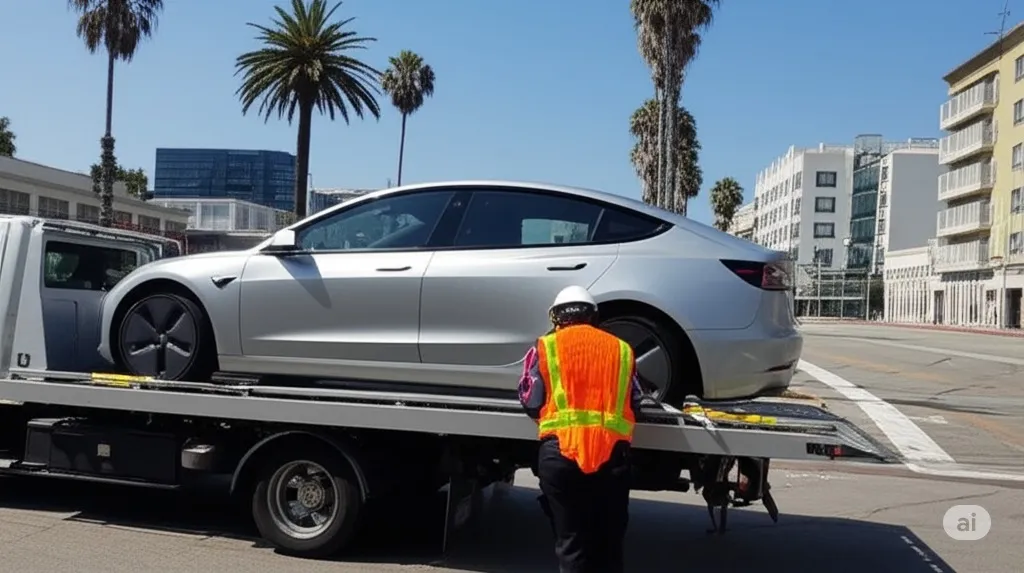Why EV Towing Requires a Specialized Approach
- Alex Carter
- 24 Jun 2025

Towing electric vehicles (EVs) in Los Angeles presents unique challenges that differ significantly from towing traditional gasoline-powered cars. As EVs become more common on city streets, towing companies and drivers alike must understand the special considerations involved to avoid costly damage and safety risks.
Challenges of Towing Electric Vehicles in Los Angeles
1. Battery Safety Concerns
The most critical challenge in towing EVs is managing the high-voltage lithium-ion battery safely. These batteries are heavy and located low in the vehicle chassis, making them vulnerable to damage if the vehicle is improperly lifted or dragged. A punctured or damaged battery can overheat, catch fire, or become unstable, posing serious hazards during towing and transport. Additionally, EV batteries can experience thermal runaway, leading to fires that may reignite even after initial suppression, sometimes hours or days later.
Because of these risks, tow operators must ensure the EV is completely powered down, and wheels are immobilized to prevent activation of regenerative braking systems that could cause the wheels to spin and damage the motor or battery.
2. Preference for Flatbed Towing
Due to the EV’s design and risk factors, flatbed towing is widely regarded as the safest method. Unlike dolly or wheel-lift towing, which leave some wheels on the ground and spinning, flatbed towing involves loading the entire vehicle onto a truck bed. This eliminates the risk of drivetrain or motor damage caused by spinning wheels and protects the battery pack from undercarriage damage due to low ground clearance.
In Los Angeles, where traffic and road conditions can be challenging, flatbed towing also minimizes the risk of further damage during transport. However, not all tow trucks are equipped with flatbeds or have the specialized equipment to handle EVs, which can lead to longer wait times and higher service costs.
3. Technician Training and Specialized Knowledge
Electric vehicles have complex software systems that manage battery usage, braking, and other critical functions. During towing, this software must be properly configured, such as activating transport or tow modes to disengage motors and prevent damage. Each EV manufacturer may have specific towing guidelines that tow operators must follow precisely.
Unfortunately, many towing professionals lack specialized training for EVs, which increases the risk of improper handling. Proper training is essential to understand how to safely power down the vehicle, engage transport modes, and use the correct equipment. In Los Angeles, where EV adoption is high, investing in technician training is critical for towing companies to provide safe and efficient service.
4. Risks of Improper Towing
Improper towing methods can cause severe damage to an EV’s battery, electric motor, and electronic systems. For example, towing with wheels on the ground can cause the motor to spin uncontrollably, leading to mechanical damage. Dragging or lifting the vehicle incorrectly can harm the battery pack or undercarriage due to low clearance.
Moreover, damaged batteries can pose ongoing fire risks during towing and storage. Cases have been reported where tow trucks were damaged or drivers injured due to battery fires or reignition incidents. Therefore, emergency protocols often include storing damaged EVs away from combustible materials and having fire suppression teams monitor the vehicle during transport.
Conclusion
Towing electric vehicles in Los Angeles requires careful attention to battery safety, preferred use of flatbed tow trucks, and specialized technician training. The unique design and technology of EVs mean that improper towing can lead to costly damage and safety hazards, including fire risks. As EVs become more prevalent, towing companies must adapt by investing in appropriate equipment and training to ensure safe, damage-free transport.
For EV owners in Los Angeles, it is advisable to choose towing services experienced with electric vehicles and to understand the importance of proper towing methods to protect their investment and safety.
This overview highlights the critical aspects of towing EVs safely in a busy urban environment like Los Angeles, emphasizing the need for expertise and specialized equipment to meet the challenges posed by electric vehicle technology.
